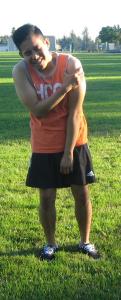The tendons are the tissues that are responsible for connecting the muscles to bones and are recurrently injured during sports and engaging in jobs that involve repetitive movements. It is important to note that tendonitis is usually given as a diagnosis to any inflammation and irritation to a particular tendon in the body. Even though tendonitis can occur in any of the tendons in the body, it is quite common in the elbows, shoulders, wrists and heels.
First aid for acute tendonitis
During the primary stages of tendonitis, the pain that is experienced by the individual is essentially worse at the start of an activity and reduces after the tendon was given enough time to warm up. Early modification of an activity such as avoiding the exercise that triggered the injury is vital in the treatment of acute tendonitis.

You have to apply an ice pack for 20 minutes at a time at several times in a day and after activity in order to control the pain and inflammation. The doctor will recommend over-the-counter pain medications such as ibuprofen or aspirin. In case there is no improvement after 10 days, the affected area must be properly assessed by a doctor to determine the exact cause. By enrolling in a class on first aid today, you will learn how to carry out these measures.
Physical therapy
In some circumstances, the doctor will prescribe a course of physical therapy in case the initial first aid measures could not provide relief to the condition. The usual course of physical therapy typically involves 2-3 visits in a week for 3 weeks.
The physical therapist will use different modalities to promote the healing of the affected tissues and reduce inflammation such as hot packs, ultrasound, electric stimulation, cold laser and ice packs. Other methods that might be used include stretching, massage and injury-specific exercises. In some cases, the physical therapist will recommend the use of elastic supports, braces or shoe inserts.
Injections
In case the symptoms continue to persist for several weeks even if physical therapy and activity modification was done, the doctor might recommend an anti-inflammatory injection. These cortisone injections are combined with novocaine in order to reduce the pain once the injection is being administered.
Take note that it is uncommon to experience an increase in pain for 24 hours right after a cortisone injection and then followed by the improvement of the symptoms. It is impossible to predict if one or several injections are required since it will depend on the assessment of the doctor as well as the overall condition of the individual.
If an individual is suspected with tendonitis, it is best to consult a doctor for proper diagnosis. This will ensure that the condition will be treated early and appropriately for proper healing and a fast recovery period.
